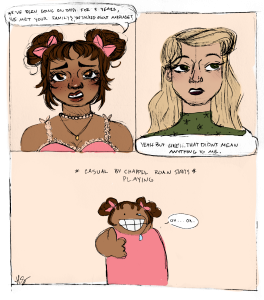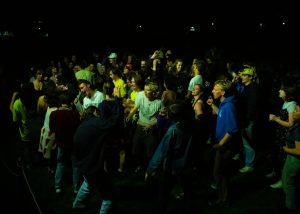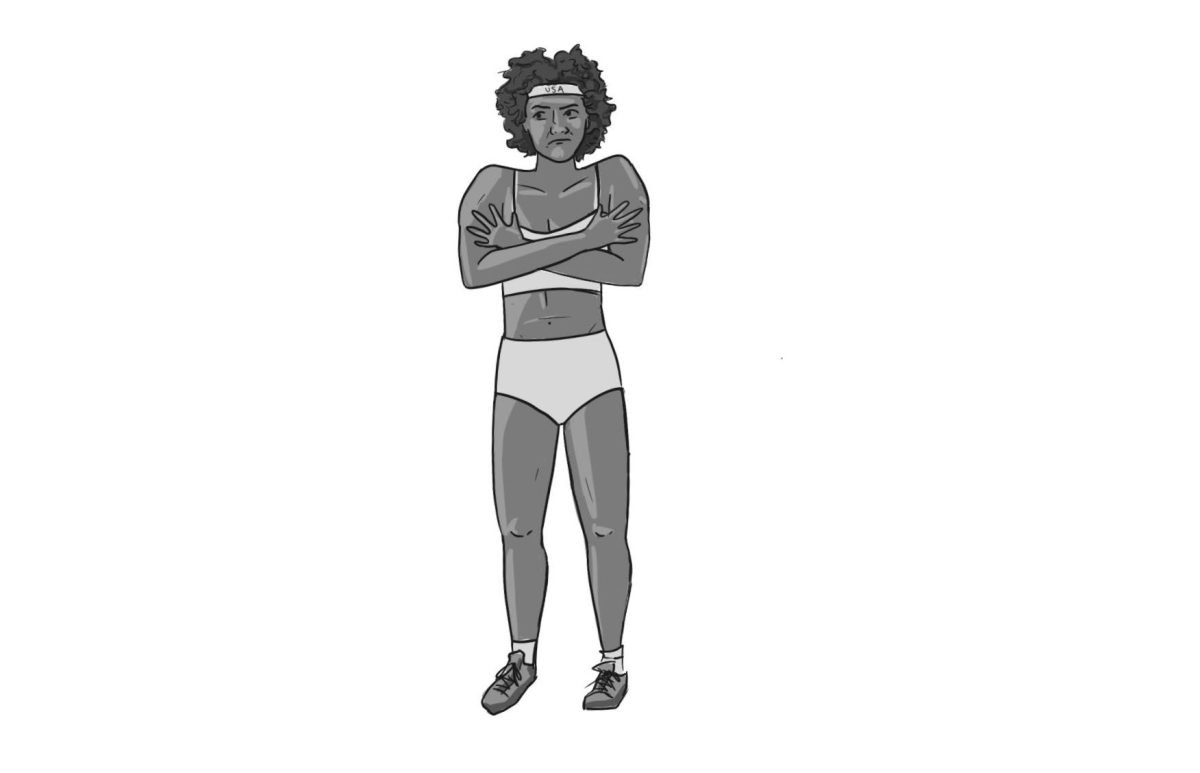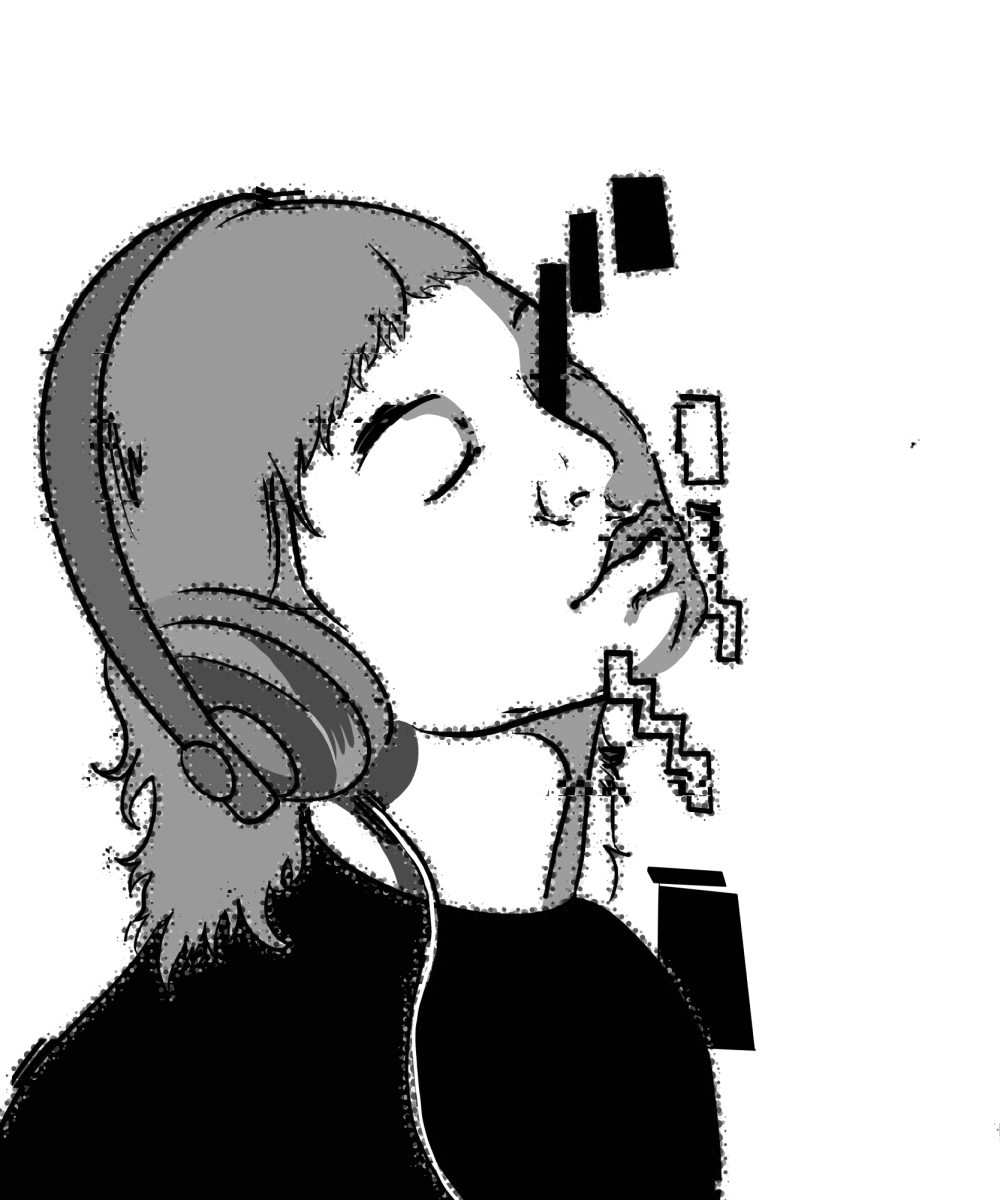On Sunday morning, the PII students gathered in front of Rifare to board the bus to the Noto Peninsula. It was a cool and drizzly morning, and we were all kind of worried that the bad weather would persist for the duration of our trip, but the sensei tachi (group of professors) assured us that it would clear up. The bus ride was a long, meandering drive up the coast, and the cityscape of Kanazawa soon gave way to suburbs, then to stretches of rice paddies and hills covered in greenery.
We stopped several times along the way to Kagaya, the ryoukan (traditional inn) where we spent the night, in order to check out some tourist spots in Noto. We took our first detour in order to ride down the Chirihama Beach Driveway, an eight-kilometer long stretch of beach with tightly packed sand firm enough to allow cars and buses to drive along right next to the sea. We were literally right next to the ocean, and waves would occasionally roll up under our bus. It was pretty extraordinary and unlike anything I had experienced before. According to an article I read later about the Beach Driveway, there are only three beaches in the world on which you can take a drive with your own car: Daytona Beach in Florida, Waitarere Beach in New Zealand, and Chirihama Beach.


After driving along the beach, we parked next to a small gift shop and were let out to walk along the seashore for about half an hour. I waded into the water and was pleased to find it much warmer than my native Northern California beaches or Lake Tahoe, despite the overcast weather. It would have been warm enough to swim in had I brought my swimsuit. We all tracked a lot of sand with us back into the bus, and it remained stuck between my toes for the rest of the day.

Our next stop was at Keta Taisha shrine, which according to Shintoism houses Ookuni-nushi-no-Mikoto, a deity of marriage. The shrine’s head priest came out to meet us, resplendent in a white robe and calling out “Makino-sensei! Ohisashiburi!” (Makino-sensei, long time no see!). He addressed us all in mumbled and heavily accented English (he probably would have been better understood in Japanese, but oh well), and gave us a tour of the shrine. Before entering the grounds of a Shinto shrine, you stop at a little fountain and wash your hands, then take some of the water into your mouth and spit it out in order to symbolically purify yourself before visiting the sacred site. This custom is one of my favorite parts of entering a shrine, because usually the water is really pure and tastes really good (though you’re not supposed to swallow it).

We went immediately from Keta Taisha to Myoujoji, a Buddhist temple famous for its five-story pagoda, the largest pagoda in the Hokuriku region of Japan. The pagoda was indeed spectacular, but the temple also had a beautiful garden with water lilies and a very serene graveyard that we also got to explore during our time there.

Our last stop before Kagaya was Ganmon, a big sea cave created by erosion. The cave itself wasn’t exactly the most impressive thing I’ve ever seen, but the area surrounding the cave was beautiful. Walking around the area, I climbed up to a high bridge connecting two large rocky hills and looked out over the ocean. According to a blurb of information we received in our Noto Trip orientation packet, “The nature at Ganmon appears in one of its most defiant and powerful moods.” Couldn’t have said it better myself.



We finally arrived at Kagaya at around 4:00 p.m. As the bus pulled up in front of the hotel, we saw that most of the hotel staff had assembled in a line in front to greet us as we pulled up. As we passed by the staff members on our way in, each of them bowed in turn and called “Irrashaimase!” (Welcome and thank you for your patronage). We were led around on a tour of the hotel by a staff member who pointed out the entrances to the hotel’s two onsen facilities, then took us to the hotel kitchen to show us Kagaya’s specialized food delivery system. At Kagaya, the elaborate kaiseki style meals are loaded onto carts, then hoisted up on a sort of huge dumbwaiter-like contraption to the various floors. Very specialized and very Japanese, this food delivery system is clearly one of the hotel’s proudest achievements. We even received an informative pamphlet about it.
Kagaya is probably the nicest hotel I’ve ever been in. I told my dad later in an email that I was pretty sure that a significant portion of the PII students’ tuition went towards reservations at this swanky hotel. The ryoukan-style rooms at Kagaya were enormous, even taking into account the fact that five of us were sharing the space. The floors were covered in tatami (Japanese bamboo mats), and there were squat little tables and chairs for sitting on the floor. As we were settling into the room, a hotel staff member came in to serve us green tea and sweets. As we sipped our tea, we all agreed that we could easily get used to this kind of luxurious lifestyle.

After tea, we donned our yukata (cotton robes provided by the hotel for wearing to and from the bath) and headed to the onsen. You don’t wear anything under your yukata, and you undress in the changing room and heading into the onsen completely naked. Some of the (American) girls in the group found this predictably uncomfortable, and undressed bashfully, covering themselves with towels. One girl who had grown up in Nigeria looked on these embarrassed girls with disdain, quipping, “Wow, you really are American, aren’t you?” I guess we Americans are known worldwide for our prudishness about nudity (among other things). In fact, the only thing that made getting naked awkward was these girls’ discomfort. It’s pretty obvious once you enter the onsen that no one has any interest whatsoever in your naked body, and that the atmosphere is totally devoid of any judgement or sexuality. As I had been to an onsen before, I already knew this; however, I remember my own hesitation to strip down in front of strangers and was glad to see the girls relax once they had become accustomed to the environment.
Soaking in the onsen was an absolutely heavenly experience. The water was incredibly hot, and while you sat in the water you could look out of this huge window over the bay. After the super-stressful week I’d just had, followed by the busy morning touring the various points of interest on the Noto Peninsula, a long bath was very welcome indeed.
We returned to our rooms to find that two hotel staff members had been sent to help us into our dinner yukata, which were much more colorful and fancier than the bath yukata. I chose a pink yukata with flowers and a purple and yellow obi (sash), but since there were so many girls queued up to put theirs on, I was the last one to get dressed. I hurried down to the fourth floor from my seventh floor room, looking for the dining room where we would eat dinner. I noticed an open door and a darkened room with a disco ball flashing inside. Approaching the door tentatively, I was surprised when about 10 of my PII classmates dashed by, all wearing flashing Minnie Mouse ear headbands and carrying lollipops and chocolate covered bananas. As soon as I entered the room, I too was presented with a drink, lollipop, and chocolate covered banana (alas, no Minnie Mouse ears) and greeted with cries of delight from a bunch of really young-looking hotel staff. The whole affair was like a carnival, with people running around and carrying balloons and posing for pictures. I felt as though I was 5 years old again.
I think the purpose of the carnival must have been to get us pumped up for dinner, because the whole thing ended rather abruptly after about a dozen group photos and we were led into a large dining hall. We sat on the floor at long tables adorned with flags representing the home countries of the PII students: America, China, Spain, Switzerland, France, Bosnia, Singapore and Korea, among others. The dinner was kaiseki-style, meaning there were several courses of elegantly prepared small dishes. (Fun fact: kaiseki originated from the tea ceremony, during which a tea master would sometimes serve his guest a small meal to accompany the tea.) There were 10 courses in all, and although I managed to taste everything put in front of me, there was no way I could have eaten it all. Foolishly thinking that the first course was the entire meal, I ate it all before realizing there were nine more courses to go. The hotel staff had been told of my vegetarianism in advance, so I got to enjoy some vegetarian alternatives to the sashimi and shellfish my classmates ate. Probably my favorite food served was a roasted half of eggplant with miso sauce.

Perhaps the most unusual offering at dinner was a dish translated into English on the menu as “dried sea cucumber,” but according to a Chinese student who read the kanji on the Japanese menu, it was “sea cucumber ovary.” This special delicacy was served to non-vegetarians in a little bowl with a significant-looking little label, and I later heard from an Ishikawa Foundation for International Exchange staff member that dried sea cucumber/sea cucumber ovary is really expensive.
During the meal we were treated to entertainment by the hotel staff, including taiko drumming and mochi-making (mochi is a Japanese sweet made with glutinous rice flour, traditionally created by pounding the flour and water into a paste with a huge mallet). After we had eaten, we were invited to get up and dance with the hotel staff, who showed us the steps to a really fun traditional dance performed with noisemakers that we got to keep afterwards as souvenirs. Great, I thought, Just what this group needs: another way to make noise.


Full to bursting, we headed back to our rooms around 9:00 PM (the dinner took about two and a half hours). Some of the students almost immediately commenced with partying, readily indulging in alcohol bought earlier from a konbini. Knowing that we had to get up early for another very full day the next morning, I decided not to participate in the bacchanal and headed back to the onsen instead. This time, I went to the other onsen facility, this one much bigger than the first and including two hot baths, one outside bath, and a cold bath.
I finally went to sleep around midnight, wisely deciding to put in earplugs before I collapsed onto the futon that the hotel staff had laid out on the floor while I was out. (Note: when Americans think of a futon, we usually think of a pull-out couch bed. However, futon originated in Japan, where they’re sleeping pads laid out on the floor with a kind of duvet-type blanket to keep you warm.) I was really thankful for the earplugs, as around 2 a.m. the rest of the crew came back from imbibing heavily, laughing and talking raucously. Although my brain acknowledged their presence in the room, I didn’t truly wake up and more or less slept though the night.
The next morning we gathered for breakfast, which was extraordinarily much the same affair as dinner had been: kaiseki-style, with LOTS of small dishes. I could barely eat anything, as I’m not much of a breakfast person to begin with and I was still full from the night before. I drank some orange juice and ate miso soup and rice, and that was really all I could manage. I felt guilty about leaving so much food on my plate, but I figured I wouldn’t do myself any favors by forcing myself to eat the morning of a busy day.

We traveled back to Kanazawa in the same way we left it, in a meandering journey through the Noto Peninsula with multiple stops. We first drove to Wajima to tour and shop at the Wajima Morning Market, where you can buy fresh fish, fruits and vegetables and traditional crafts. The Market has a history of over one thousand years, and the stalls are almost exclusively run by older Japanese women who call out to you as you pass, asking, “How are you today? Wouldn’t you like to buy some fruit/fish/bowls?” I stopped in a few shops to take a look at the famous Wajima lacquerware, as Takemoto sensei has told me about it on several occasions at Whitman and in fact owns a very beautiful Wajima lacquer natsume (tea container) that we use for chanoyu. I saw some very elegant natsume, all of them extremely expensive. In fact, there was such a dichotomy between the prices of the good quality crafts (really pricy) and the cheaper-looking wares (affordable) that I didn’t actually end up buying anything except some rather costly carrots. I ate some of these on the bus on the way home, earning the nickname “Usagi-san” (Miss Rabbit) from some of the other PII students.

We stopped off next for a brief sojourn at Kiriko Museum (or Kirikokaikan in Japanese, really fun to say quickly). This museum displays huge sacred festival lanterns unique to the Noto Peninsula, which are integral parts of the region’s summer festivals. The enormously tall lanterns are hoisted up, usually with musicians standing on the platforms as well, and carried around during festivals. The lanterns were very impressive, towering and glowing softly in the dimly lit museum. Next door to Kirikokaikan was a traditional crafts shop/dining hall (I know, I was confused, too) where we stopped to take a look at the process behind creating the Noto area’s renowned lacquerware. I was astonished to see a craftsman picking up tiny fragments of colored seashell and meticulously applying them one by one with tweezers to a lacquered surface in a precise pattern. So much of the work that goes into lacquerware is still done by hand in Japan, so it’s really no wonder that the lacquerware at the Wajima Morning Market was so expensive.


From Kirikokaikan we drove to Senmaida, a beautiful terraced rice field facing the ocean. As we walked along the path next to the field, we saw tadpoles swimming in the paddy’s irrigation system and even spotted a snake hiding under a rock.
Our last stop before returning to Kanazawa was the Okunoto Salt Field, well-known for its use of the so-called “fried salt beach formula” (that’s what our informative packet told us, anyway). The salt harvesters draw salt water from the sea and pour it out over a bed of fine-grained sand, letting the water evaporate to leave the salt behind. We saw an older gentleman throwing the water out over the sand, and although it looked like a fairly straightforward process, we found out that there’s a particular technique you have to use when dumping out the saltwater in order to make sure that it’s properly distributed over the sand. A couple of the PII students tried throwing the water around, only to discover that it was a lot more difficult than it initially appeared!


I slept most of the way back to Kanazawa, waking only to eat another carrot and change the playlist on my iPod. I was completely wiped out. On my walk home from Nishi Kanazawa Station, I stopped in a bakery specializing in macaroons and picked up some fancy, colorful cookies in various flavors for Ai-san and the boys. I pass by the shop every day on my way to and from school, and I had long been intrigued by the pictures of posh-looking macaroons. The lady working in the store was really nice and the macaroons were awesome (I sampled a delicious pistachio-flavored cookie), so I’ll definitely be stopping back in there to buy omiyagi (souvenirs) for the Japanese friends I plan to visit before my time here comes to an end.
Ha-chan was especially delighted upon my return home and immediately roped me into playing Legos with him. Re-chan was acting quite the adult, asking me questions like “How was the hotel?” and “Did you enjoy yourself?” in a dignified manner while he completed his homework. He soon lost the formal tone and proudly showed me some drawings of Mario and Luigi he had created while I had been gone.
I was really happy to be home after the long and busy weekend, but with a short presentation the next day and an impending test on Wednesday, I had to put my nose back to the grindstone mere hours after my return. The Noto trip was by far one of the most fun activities we’ve done as a group so far, and I am very surprised and grateful that PII decided to treat us to such a lavish trip. It’s definitely a weekend I will never forget!









